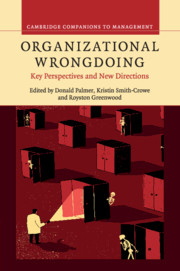Book contents
- Frontmatter
- Contents
- List of figures
- List of tables
- List of contributors
- Foreword
- 1 The imbalances and limitations of theory and research on organizational wrongdoing
- 2 On taking the theoretical substance of outcomes seriously: a meta-conversation
- 3 Wrong paths to right: defining morality with or without a clear red line
- 4 From market enablers to market participants: redefining organizational and political-legal arrangements and opportunities for financial wrongdoing,1930s–2000
- 5 Wrongdoing and market development: an examination of the distinct roles of trust and distrust
- 6 Bad apples, bad barrels and bad cellars: a “boundaries” perspective on professional misconduct
- 7 S/he blinded me with science: the sociology of scientific misconduct
- 8 Social networks and organizational wrongdoing in context
- 9 Falling stars: celebrity, infamy, and the fall from (and return to) grace
- 10 Compensation and employee misconduct: the inseparability of productive and counterproductive behavior in firms
- 11 Beware of organizational saints: how a moral self-concept may foster immoral behavior
- 12 “Is it me? Or is it me?” The role of coactivated multiple identities and identifications in promoting or discouraging workplace crimes
- 13 Consequences of organizational misconduct: too much and too little punishment
- 14 Who bears the brunt? A review and research agenda for the consequences of organizational wrongdoing for individuals
- 15 Organizational wrongdoing and media bias
- 16 Ethical learning: releasing the moral unicorn
- Index
- References
8 - Social networks and organizational wrongdoing in context
Published online by Cambridge University Press: 05 July 2016
- Frontmatter
- Contents
- List of figures
- List of tables
- List of contributors
- Foreword
- 1 The imbalances and limitations of theory and research on organizational wrongdoing
- 2 On taking the theoretical substance of outcomes seriously: a meta-conversation
- 3 Wrong paths to right: defining morality with or without a clear red line
- 4 From market enablers to market participants: redefining organizational and political-legal arrangements and opportunities for financial wrongdoing,1930s–2000
- 5 Wrongdoing and market development: an examination of the distinct roles of trust and distrust
- 6 Bad apples, bad barrels and bad cellars: a “boundaries” perspective on professional misconduct
- 7 S/he blinded me with science: the sociology of scientific misconduct
- 8 Social networks and organizational wrongdoing in context
- 9 Falling stars: celebrity, infamy, and the fall from (and return to) grace
- 10 Compensation and employee misconduct: the inseparability of productive and counterproductive behavior in firms
- 11 Beware of organizational saints: how a moral self-concept may foster immoral behavior
- 12 “Is it me? Or is it me?” The role of coactivated multiple identities and identifications in promoting or discouraging workplace crimes
- 13 Consequences of organizational misconduct: too much and too little punishment
- 14 Who bears the brunt? A review and research agenda for the consequences of organizational wrongdoing for individuals
- 15 Organizational wrongdoing and media bias
- 16 Ethical learning: releasing the moral unicorn
- Index
- References
Summary
This chapter critically reviews extant social network theory and research on misconduct in and by organizations, focusing primarily on the individual level of analysis and considering the role that social networks play in the initiation, diffusion, effectiveness, and demise of wrongdoing. We conclude that a more comprehensive understanding of the role of social networks in wrongdoing in and by organizations hinges on four contextual factors: (1) the predispositions of the actors involved, (2) the nature of the wrongdoing in question, (3) the institutional environment in which the wrongdoing is perpetrated, and (4) the temporal dynamics through which the wrongdoing unfolds. We also conclude that a more nuanced understanding of the role of social networks in organizational wrongdoing requires greater attention to the quality and type of relationship that a given social tie represents, more extensive utilization of qualitative research methods, learning from emerging social network theory and research in other disciplines, particularly criminology, and further incorporation of the organizational level of analysis.
Introduction
Theory and research on social networks has a long tradition in sociology, social psychology, and anthropology and an increasing presence in organizational studies. In this chapter, we critically review the embryonic but growing body of social network theory and research on misconduct in and by organizations. We structure our review around the three main areas of prior research: the role of social networks in the initiation, evolution, and consequences of wrongdoing. We use Brass, Butterfield, and Skaggs’ (1998) seminal theoretical analysis of the role that social networks play in unethical behavior as the starting point for our review, which reaffirms, extends, and in some cases suggests modifications to their arguments. We tap a range of empirical studies on social networks and organizational misconduct, most importantly a series of investigations by Baker, Faulkner, and associates (Baker and Faulkner 1993, 2003, 2004; Faulkner and Cheney 2014; Faulkner et al. 2003) to flesh out our discussion. We conclude that a comprehensive understanding of the role of social networks in wrongdoing in and by organizations hinges on several contextual factors that social network analyses sometimes overlook in the drive to use the patterns of relationships among wrongdoers and their victims as the dominant explanatory device. We end by suggesting several lines of inquiry that social network analysts might explore in connection with organizational wrongdoing in the future.
- Type
- Chapter
- Information
- Organizational WrongdoingKey Perspectives and New Directions, pp. 203 - 234Publisher: Cambridge University PressPrint publication year: 2016
References
- 7
- Cited by



